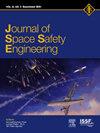Real-time air-traffic warning during satellite re-entries: Challenges and developments
IF 1.7
Q3 ENGINEERING, AEROSPACE
引用次数: 0
Abstract
Over time, new market trends are shaped by advances in technological development. The space sector is no exception to this evolution, with launches across all mass and type classes reaching record levels in recent years. In terms of re-entries, this translates into a rapid increase in the number of re-entering objects. Between 10 % and 40 % of the re-entering mass is expected to survive, posing a potential hazard to aircraft, ships and ground populations. Alongside to the uncertainty on the surviving mass, the on-ground risk assessment is still strongly affected by the uncertainties in predicting the re-entry point, which is estimated around 20 % of the remaining lifetime for an uncontrolled re-entry from a circular orbit. Despite these challenges, the theory for the on-ground risk assessment is in a certain extent harmonised within the international context of space agencies.
In contrast, the assessment of the risk that re-entering objects pose to air and sea traffic is still a major point of discussion today, with methodologies that can vary widely from one country/agency/entity to another.
This paper discusses key challenges that are currently hindering the implementation of real-time air traffic warnings during Earth’s atmospheric re-entries, ranging from technical gaps to the lack of clear metrics or a centralised coordination point, and outlines recent developments aimed at mitigating these issues.
The first section of this work provides an overview of relevant historical events and comments the international response to the increased risk, while the second section discuss the challenges for the practical implementation of a real-time risk assessment for air traffic during the re-entry of space objects, and propose near-term steps for a overcoming them.
卫星再入时的实时空中交通预警:挑战和发展
随着时间的推移,技术发展的进步塑造了新的市场趋势。航天领域也不例外,近年来,所有大规模和类型的发射都达到了创纪录的水平。就重入而言,这意味着重入对象数量的迅速增加。预计10%至40%的重入质量将存活下来,对飞机、船舶和地面人口构成潜在危险。除了幸存质量的不确定性外,地面风险评估仍然受到预测再入点的不确定性的强烈影响,估计从圆形轨道不受控制再入的剩余寿命约为20%。尽管存在这些挑战,但在空间机构的国际范围内,地面风险评估理论在一定程度上是协调一致的。相比之下,评估再入物体对空中和海上交通构成的风险仍然是今天讨论的一个主要问题,其方法可能因国家/机构/实体而大不相同。本文讨论了目前阻碍在地球重返大气层期间实施实时空中交通警报的主要挑战,从技术差距到缺乏明确的指标或集中协调点,并概述了旨在缓解这些问题的最新进展。本工作的第一部分概述了相关的历史事件,并评论了国际上对风险增加的反应,而第二部分讨论了实际实施空间物体再入期间空中交通实时风险评估所面临的挑战,并提出了克服这些挑战的近期步骤。
本文章由计算机程序翻译,如有差异,请以英文原文为准。
求助全文
约1分钟内获得全文
求助全文
来源期刊

Journal of Space Safety Engineering
Engineering-Safety, Risk, Reliability and Quality
CiteScore
2.50
自引率
0.00%
发文量
80
 求助内容:
求助内容: 应助结果提醒方式:
应助结果提醒方式:


